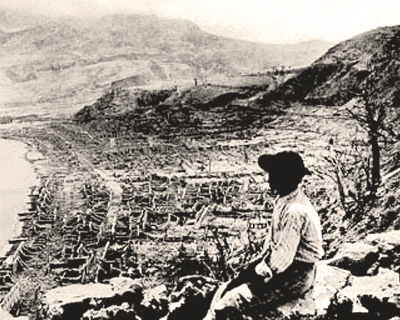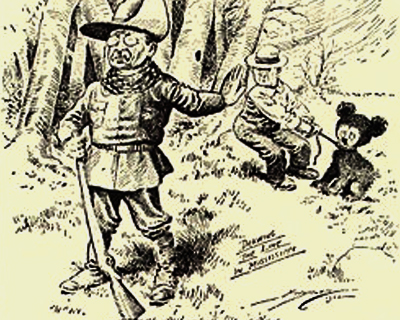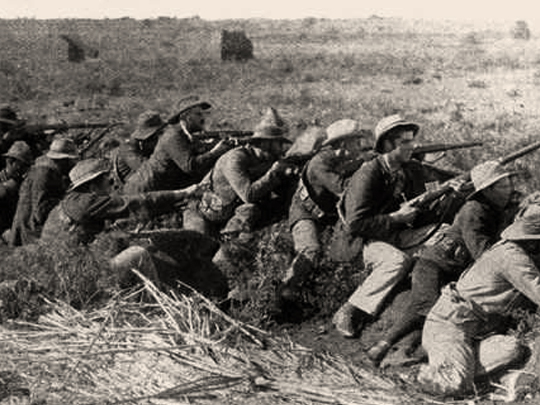Skeoch Cumming W / Wikimedia Commons / CC-BY-SA-3.0 / GFDL
1 – Second Boer War Ends
The Second Boer War was fought from October 11, 1899, until May 31, 1902. It was fought in South Africa between the British and the Boers (Dutch settlers in southern Africa).
The war saw the first use of concentration camps by British forces under the command of Lord Horatio Herbert Kitchener. There was a scarcity of food and water in the camps, with starvation and disease-causing the deaths of over 20,000 women and children.
Black Africans were also interred in segregated camps, generally as a source of cheap labor for the gold mines.
The concentration camps were widely criticized in Europe and severely damaged the reputation of the British government, all the while furthering the Boer’s cause for nationalism.
The harsh tactics of the British eventually cracked the Boer’s morale, causing their eventual surrender in 1902. Boer leaders accepted the peace conditions and signed the Treaty of Vereeniging on May 31st.
The result of the treaty meant the British gained control over all of the colonies in South Africa. Eventually the British created the Republic of South Africa, an independent country uniting all the colonies into one.
2 – The Deadliest Volcanic Eruption of the 20th Century

The town of St. Pierre, on the island of Martinique, was known as the “Paris of the Caribbean.” On May 8th, however, the town of 30,000 inhabitants was completely destroyed within minutes, following the eruption of Mount Pelée.
Most of the victims perished from suffocation and burns that scorched their skin and lungs. A subsequent analysis of burnt wood suggests the temperature of the gas cloud was between 350 and 400 degrees Celsius.
Only three people survived from the direct path of the flows. Louis-Auguste Cyparis, who later toured with the Barnum and Bailey Circus, survived because he was in a dungeon-like jail cell.
Léon Compère-Léandre, a shoemaker living on the outskirts of the town, escaped with severe burns. Havivra Da Ifrile, a young girl, escaped with injuries by taking a small boat to a cave down the shore, she was later found unconscious and two miles adrift.
A passenger steamship, the Roraima, had reached the port of Saint-Pierre at 6:30 AM, shortly before the eruption, and was set aflame by the pyroclastic flow, causing it to later sink.
Twenty-eight of the crew and all the passengers except two, a little girl and her creole nurse, were killed by the cloud. The wreck is still present off the shore of Saint-Pierre.
It was to be the deadliest volcanic eruption in the world following the turn of the twentieth century. The town of Saint-Pierre was never fully rebuilt, though some villages grew up in its place.
3 – The Teddy Bear was inspired by US President Roosevelt

Clifford Berryman / Wikimedia Commons / CC-BY-SA-3.0 / GFDL
The name ‘teddy bear’ comes from the nickname given to former United States President Theodore Roosevelt. In November 1902, Roosevelt was on a bear hunting trip in Mississippi which inspired the name.
A number of Roosevelt’s attendants cornered, clubbed, and tied an American Black Bear to a tree after an exhausting chase with hounds.
They called Roosevelt to the site and suggested he should shoot it. He refused, thinking it to be unsportsmanlike in a competitive hunt, but instructed that the bear be killed to put it out of its misery.
The episode became the topic of a political cartoon (shown above) by Clifford Berryman in The Washington Post on November 16th.
The initial cartoon was of an adult black bear lassoed by a handler and a disgusted Roosevelt, but later issues of that and other Berryman cartoons made the bear smaller and cuter.
Morris Michtom saw the drawing and was inspired to create a teddy bear. He made a small soft bear cub and put it in his shop window with a sign “Teddy’s bear”, after reportedly having sent a bear to Roosevelt and received permission to use his name.
The bears became an instant success, and Michtom went on to start the ‘Ideal Novelty and Toy Company’.
Curiously, at the same time in Germany, the Steiff firm, unaware of Michtom’s bear, produced a stuffed bear also. Richard Steiff modeled it after real-life bears he had sketched at the zoo and exhibited the toy at a Toy Fair in March 1903.
Even though Steiff and Michtom were both making teddy bears at around the same time, neither would have known of the other’s creation due to poor transatlantic communication.
Over a century later, Steiff’s toy company continues to make stuffed teddy bears, while Michtom’s ‘Ideal Novelty and Toy Company’ ceased trading in 1997.
4 – Cuba gained independence from Spain
The Spanish-American War resulted in the Spanish withdrawing from Cuba in 1898. In the presidential elections of 31st December 1901, Tomás Estrada Palma, a U.S. citizen still living in the United States, was the only candidate.
His opponent, General Bartolomé Masó, withdrew his candidacy in protest against U.S. favoritism and the manipulation of the political machine by Palma’s followers.
Palma was elected the Republic’s first President, although he only returned to Cuba four months after the election.
The U.S. occupation officially ended when Palma took office on May 20th, as Cuba formally gained independence.
Under Cuba’s new constitution, the U.S. retained the right to intervene in Cuban affairs and to supervise its finances and foreign relations. Also, Guantanamo Bay was leased to the United States as part of the Platt Amendment.
In the years after gaining independence, Cuba saw significant economic development.
However, political instability and corruption led to a succession of despotic leaders, culminating in the overthrow of Fulgencio Batista by the 26th of July Movement, led by Fidel and Raúl Castro, during the 1953–59 Cuban Revolution.









